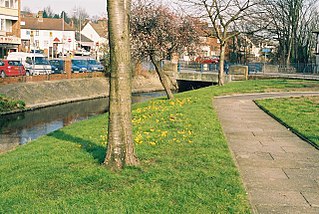
Crayford is a town and electoral ward in South East London, England, within the London Borough of Bexley. It lies east of Bexleyheath and north west of Dartford. Crayford is in the historic county of Kent. The settlement developed by the river Cray, around a ford that is no longer used.

Erith is an area in south-east London, England, 13.3 miles (21.4 km) east of Charing Cross. Within the historic county of Kent, it has formed part of the London Borough of Bexley since 1965. It lies north-east of Bexleyheath and north-west of Dartford, on the south bank of the River Thames. The population is 45,345. The town centre has been modernised with further dwellings added since 1961. The curved riverside high street has three listed buildings, including the Church of England church and the Carnegie Building. Erith otherwise consists mainly of suburban housing. It is linked to central London and Kent by rail and to Thamesmead by a dual carriageway. It has the longest pier in London, and retains a coastal environment with salt marshes alongside industrial land.
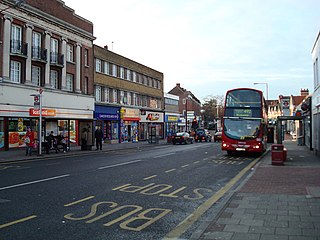
Sidcup is an area of south-east London, England, primarily in the London Borough of Bexley. It is 11.3 miles (18.2 km) south-east of Charing Cross, bordering the London Boroughs of Bromley and Greenwich, and is in the historic county of Kent.

Welling is an area of South East London, England, within the London Borough of Bexley and the boundaries of the historic county of Kent. It is 1.5 miles (2.4 km) west of Bexleyheath, 4 miles (6.4 km) south east of Woolwich and 10.5 miles (16.9 km) east-southeast of Charing Cross, the traditional centre of London.

The London Borough of Bexley is a London borough in south-east London, forming part of Outer London. It has a population of 248,287. The main settlements are Sidcup, Erith, Bexleyheath, Crayford, Welling and Old Bexley. The London Borough of Bexley is within the Thames Gateway, an area designated as a national priority for urban regeneration. The local authority is Bexley London Borough Council.

Bexley is an area of south-eastern Greater London, England and part of the London Borough of Bexley. It is sometimes known as Bexley Village or Old Bexley to differentiate the area from the wider borough. It is located 13 miles (21 km) east-southeast of Charing Cross and south of Bexleyheath.

Erith station serves Erith in the London Borough of Bexley, southeast London. It is 14 miles 18 chains (22.9 km) measured from London Charing Cross.

Barnehurst is a town and electoral ward in South East London within the London Borough of Bexley. It lies north east of Bexleyheath, and 13.0 miles (20 km) east south-east of Charing Cross. It is separated from North Bexleyheath by the A220, Erith Road.
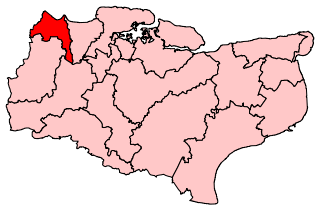
Dartford is a constituency represented in the House of Commons of the UK Parliament since 2010 by Gareth Johnson of the Conservative Party. The constituency is currently the longest-valid 'bellwether' constituency in the country as the party of the winning candidate has gone on to form the government at every UK general election since 1964. Candidates for the largest two parties nationally have polled first and second since 1923 in Dartford.

Slade Green is an area of South East London, England, within the London Borough of Bexley and the historic county of Kent. It lies northeast of Bexleyheath, northwest of Dartford and south of Erith, and 14 miles (23 km) east-southeast of Charing Cross.

Northumberland Heath is a neighbourhood and electoral ward in the London Borough of Bexley, south east London, England. Northumberland Heath is often referred to locally as "North' Heath" and is often considered to be part of upper Erith.
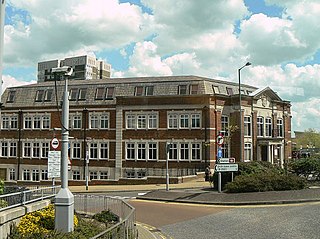
Erith was a local government district in north west Kent from 1876 to 1965 around the town of Erith. It also included the generally suburban areas of Northumberland Heath, Belvedere, and parts of Barnehurst, Bexleyheath, Crayford and the SE2 London Postal District of Abbey Wood.

Crayford was a local government district in north west Kent from 1920 to 1965 around the town of Crayford. As well as Crayford, it included Barnehurst, Barnes Cray and Slade Green.
The London Borough of Bexley owns and maintains over 100 parks and open spaces within its boundaries, with a total of 638 hectares. They include small gardens, river and woodland areas, and large parks with many sporting and other facilities.
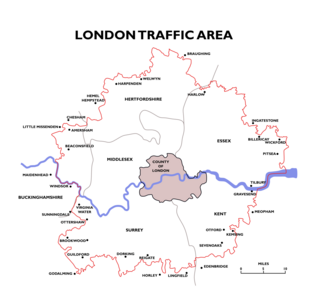
The London Traffic Area was established by the London Traffic Act 1924 to regulate the increasing amount of motor traffic in the London area. The LTA was abolished in 1965 on the establishment of the Greater London Council.
Haberdashers' Aske's School may refer to:
Erith and Crayford was a constituency which returned one Member of Parliament (MP) to the House of Commons of the UK's Parliament.
Haberdashers' Aske's Crayford Academy is a mixed secondary school and sixth form with academy status sponsored by the Worshipful Company of Haberdashers. It is located in the Crayford area of the London Borough of Bexley, England.

Little and Lesnes was a hundred, a historical land division, in the county of Kent, England. It occupied the northern part of the Lathe of Sutton-at-Hone, within in the west division of Kent. Little and Lesnes was the northernmost hundred in the whole county of Kent. The hundred existed since ancient times, before the Domesday Book of 1086, until it was made obsolete with the creation of new districts at the end of the nineteenth century.
















